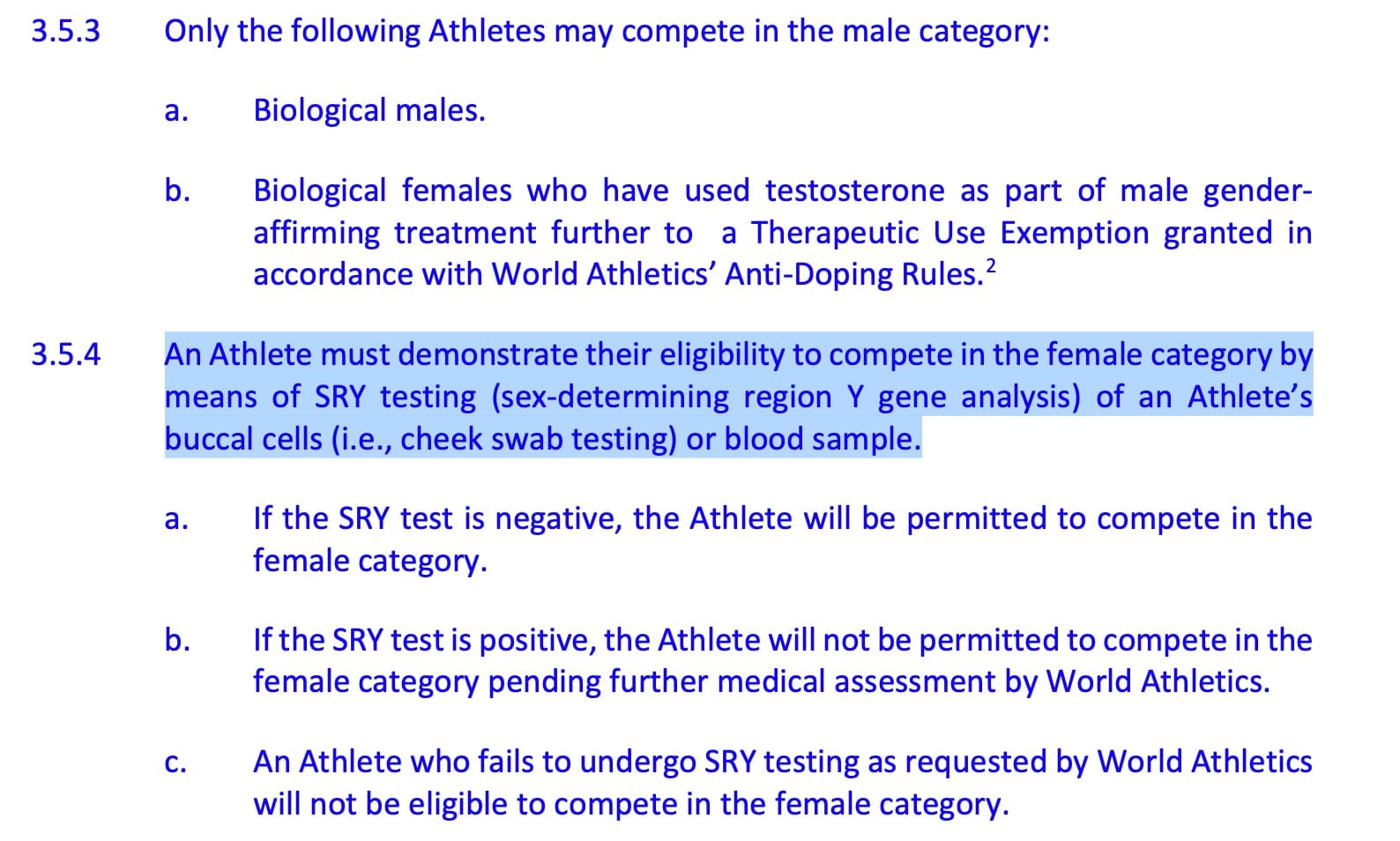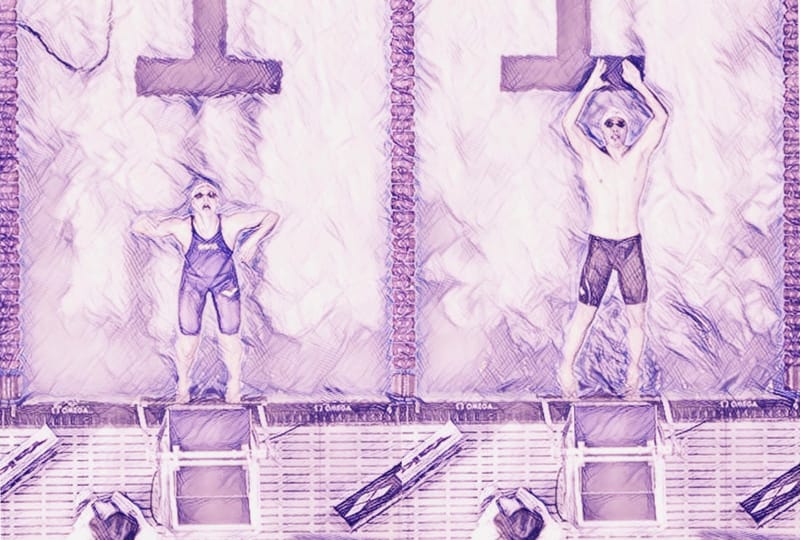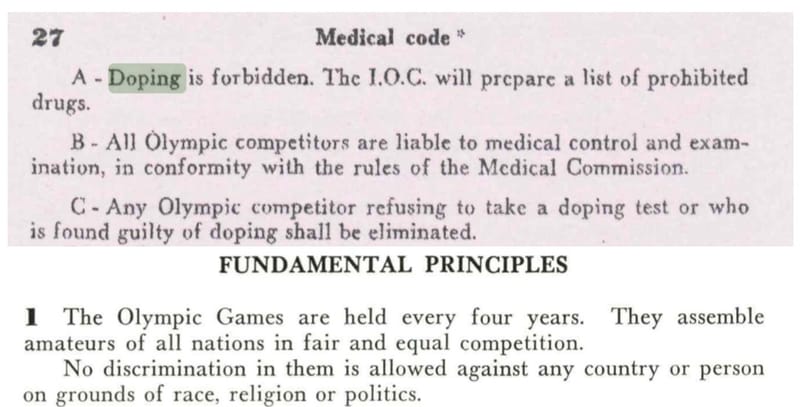Athletics Back To The Future: SRY Cheek-Swab Sex Tests Follow Revelation That Women's Worlds Finals Included '50-60 Male DSDs'
“The philosophy that we hold dear in World Athletics is the protection and the promotion of the integrity of women’s sport ... We are saying, at elite level, for you to compete in the female category, you have to be biologically female." - Sebastian Coe, as 25 years of unfair play draw to a close

Almost a decade after the International Olympic Committee removed the only serious barrier to biological all males competing in female competitions, World Athletics has revealed one of the brutal reasons why the regulator has gone back to the future by re-0adopting simple sex-test cheek swabs to ensure fair and safe play for female athletes.
That reason: between 50 and 60 athletes who went through male puberty have been finalists in female races at global and continental track and field championships since 2000.
The figures were revealed to media gathered in Tokyo at the World Championships underway there this week.
World Athletics introduced SRY screening for the event. It uses the cheek swab that female athletes were obliged to submit to between 1992 and 1999, before the IOC abandoned sex tests.
SRY screening is a genetic test to detect the presence of the Sex-Determining Region Y (SRY) gene, which is located on the Y chromosome and triggers male biological development. Athletes must return a negative result, indicating no SRY gene presence, to be eligible for the women's category in track and field. The same test is not in mandatory use (and mostly not used at all) in other Olympic sports as a result of the direction the IOC took a quarter of a century ago on the way to the crisis that has rocked women's sport since 2015.
In short: What the SRY Gene Test Does
- Identifies the Y chromosome: The SRY gene is a reliable proxy for the Y chromosome, which is typically found in individuals with male biological sex.
- Initiates male development: The SRY gene produces a protein that initiates the development of testes, which in turn produce hormones like testosterone that lead to the development of male characteristics.
The purpose of using it for testing in sport is simple: safe and fair play. At around 11-12%, swimming is at the very significant low end of the scale of sports with a big difference in performance levels (strength-and-size based) between males and females. At 11-12%, males from the top 20 to 30 swim nations who perform to a good level at the equivalent of state or county championships but may not be able to make finals at nationals, are often capable of speeds that would make Olympic and other major podiums in female competition. The same is true of the very best 15-17-year-old junior boys.
How the SRY Test Works:
- Sample collection: Athletes provide a cheek swab (or blood sample, if they choose to),
- Lab analysis: The sample is sent to a lab to extract DNA and look for the presence of the SRY gene using techniques such as quantitative real-time PCR.
Important Considerations
- DSD cases: The test is designed for athletes who are born with Differences in Sex Development (DSD), a group of conditions where a person's genes, hormones, and reproductive organs have a mix of male and female characteristics, but only one set of those is actually functional. There is no human condition in which both female and male sex organs are present and fully functional.
- Confidentiality: Test results are anonymized and protected, shared only with relevant sports authorities.
A more primitive version of cheek swab was used in sex tests between 1968 and 1992.
The history of of sex testing runs like this ...
- 1948 to 1964: Women had to take a medical certificate from their home country to competitions to verify their sex.
- 1966 to 1967: Women had to parade naked before a panel of gynaecologists before competitions and eligibility was decided on the appearance of genitalia.
- 1968 to 1992: IOC/International federations used once-in-a-lifetime sex-verification test, a cheek swab, which was required for all who did not already have a sports-issued test certificate on arrival at competitions. The cells in the swab were tested for chromosomal BARR, the presence of which is assumed to identify a multiple X chromosome, or XX, female.
- 1976 to today: Women and men have to submit to random anti-doping tests designed to detect elevated testosterone levels. Such tests are generally considered to be far more intrusive than any cheek sex swab - and they are mandatory.
- 1992 to 1999: SRY. Even so, at the Atlanta 1996 Olympics, eight women tested positive for the SRY gene but were still allowed to compete.
- 2003 to 2015: Women’s sport was no longer ring-fenced for females because the IOC allowed males identifying as women access to female sports two years after sex-reassignment surgery, including a gonadectomy or removal of testes, and a certificate confirming the sex reassignment.
- 2015 to 2021: Open Season in female sport, until World Rugby became the first sports organisation to change the game and bar biological males from female sport, ahead of World Aquatics's 2022 decision to change its rules in the same direction as the first major Olympic sport to reject IOC guidance. The IOC's move meant that surgery, the only serious barrier to biological males wishing to compete in the female category, was no longer required for eligibility. A feeling and reduction of testosterone was enough. So began the most toxic years in female sport since the GDR's systematic doping program collapsed in the rubble of the Berlin Wall in late 1989.
For far greater context and depth, here's Unfair Play, by Sharron Davies, with this author:

25-Years Of Unfair Play ...
In a presentation to a scientific panel in the Japanese capital on Friday, Dr Stéphane Bermon, head of health and science at World Athletics, outlined why the sport’s governing body believes such screens are necessary as he presented data collected over the past 25 years. He said it showed that athletes with differences of sex development (DSD), who have a 46 XY karyotype with male testes but were reported female at birth, were significantly “over-represented” in major finals and that it “compromises the integrity of the female competitions”.
In swimming, there has been no obvious cases of male DSD athletes excelling in female competition as has been the case in athletics.
Even so, World Aquatics may now consider whether to introduce the SRY tests as a safeguard for female competition in all aquatics disciplines, in line with its pledge to keep on top of the issues when it adopted rules in June 2022 that made any athlete developed past Tanner stage 2 male puberty ineligible for the female/women's category.
Related in the story of why World Athletics is keen to preserve the women's category for females:

The numbers and related stats off unfair play revealed by World Athletics follow...






